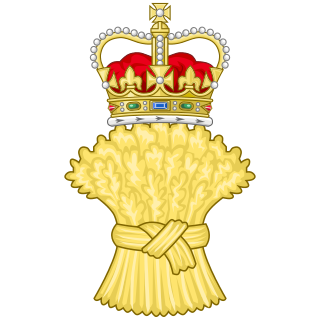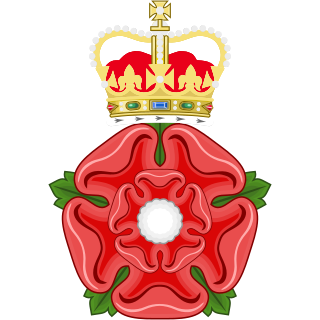
Earl Marshal is a hereditary royal officeholder and chivalric title under the sovereign of the United Kingdom used in England. He is the eighth of the great officers of State in the United Kingdom, ranking beneath the Lord High Constable of England and above the Lord High Admiral. The dukes of Norfolk have held the office since 1672.

The College of Arms, or Heralds' College, is a royal corporation consisting of professional officers of arms, with jurisdiction over England, Wales, Northern Ireland and some Commonwealth realms. The heralds are appointed by the British Sovereign and are delegated authority to act on behalf of the Crown in all matters of heraldry, the granting of new coats of arms, genealogical research and the recording of pedigrees. The College is also the official body responsible for matters relating to the flying of flags on land, and it maintains the official registers of flags and other national symbols. Though a part of the Royal Household of the United Kingdom, the College is self-financed, unsupported by any public funds.

New Zealand Herald of Arms Extraordinary is an officer of arms representing the heraldic interests of New Zealand. Although affiliated with the College of Arms in London, the New Zealand Herald lives and works in New Zealand, and is not a member of the College Chapter. Since the New Zealand Herald was appointed, there have been questions as to his legitimacy and whether, as working under the authority of the College of Arms, he has any legal authority to regulate heraldry in New Zealand. The current New Zealand Herald of Arms Extraordinary is Phillip O'Shea.

Richmond Herald of Arms in Ordinary is an officer of arms of the College of Arms in England. From 1421 to 1485, Richmond was a herald to John, Duke of Bedford, George, Duke of Clarence, and Henry, Earl of Richmond, all of whom held the Honour (estate) of Richmond. However, on the accession of Henry as Henry VII of England in 1485, Richmond became a king of arms and remained so until 1510, when the office became that of a herald in ordinary of the Crown. The badge of office is a red rose of Lancaster dimidiating the white rose en soleil of York, ensigned by the royal crown. Although this device has all the characteristics of a Tudor invention, it is likely to be of fairly recent derivation.

Chester Herald of Arms in Ordinary is an officer of arms at the College of Arms in London. The office of Chester Herald dates from the 14th century, and it is reputed that the holder was herald to Edward, Prince of Wales, also known as the Black Prince. In the reign of King Richard II the officer was attached to the Principality of Chester, which was a perquisite of the then Prince of Wales. In the reign of King Henry VIII the title lapsed for a time but, since 1525, the office of Chester has been one of unbroken succession, as a herald in ordinary. The badge of office is taken from the arms of the Earl of Chester and in blazoned as A Garb ensigned of the Royal Crown Or.

Lancaster Herald of Arms in Ordinary is an English officer of arms at the College of Arms in London. The title of Lancaster Herald first occurs in 1347 at Calais, and to begin with this officer was a servant to the noble house of Lancaster. As a retainer of John of Gaunt (1377–1399) Lancaster was advanced to the rank of King of Arms, and was later promoted to the royal household of Henry IV, and made king of the northern province. This arrangement continued until 1464, when Lancaster reverted to the rank of herald. Since the reign of King Henry VII (1485–1509) Lancaster has been a herald in ordinary. The badge of office is a red rose of Lancaster, royally crowned.

York Herald of Arms in Ordinary is an officer of arms at the College of Arms. The first York Herald is believed to have been an officer to Edmund of Langley, Duke of York around the year 1385, but the first completely reliable reference to such a herald is in February 1484, when John Water alias Yorke, herald was granted certain fees by Richard III. These fees included the Manor of Bayhall in Pembury, Kent, and 8 pounds, 6 shillings, and 8 pence a year from the Lordship of Huntingfield in Kent. The badge of office is the White Rose of York en soleil ensigned by the Royal Crown.

Somerset Herald of Arms in Ordinary is an officer of arms at the College of Arms in London. In the year 1448 Somerset Herald is known to have served the Duke of Somerset, but by the time of the coronation of King Henry VII in 1485 his successor appears to have been raised to the rank of a royal officer, when he was the only herald to receive coronation liveries.

Windsor Herald of Arms in Ordinary is an officer of arms at the College of Arms in London.

Arundel Herald of Arms Extraordinary is a supernumerary Officer of Arms in England. Though a royal herald, Arundel is not a member of the College of Arms, and was originally a private herald in the household of Thomas Fitzalan, Earl of Arundel. The first herald, John Cosoun, is known to have served the Earl both in Portugal in 1413 and later in France, where he attended his dying master in October 1415. The title was revived in 1727 as Herald Extraordinary.

Beaumont Herald of Arms Extraordinary was an officer of arms extraordinary in England. Beaumont was a royal herald, but was not a member of the College of Arms. The office was created in 1982 and named after the barony of Beaumont, one of the subsidiary titles of the Earl Marshal, the Duke of Norfolk. The badge of office combines the cross potent of the Kings of Jerusalem from whom the Beaumonts are descended, with the lion and fleur-de-lis charges from the family coat of arms. It is blazoned In front of a Cross Potent a Lion rampant within eight Fleurs-de-lis in orle Or.

Wales Herald of Arms Extraordinary is a current Officer of Arms Extraordinary under the Courts of England and Wales' jurisdiction. Wales is a Royal Herald, ie a member of the Royal Household, and while not being a member of chapter of the College of Arms, processes with the other heralds at ceremonial occasions. Wales Herald forms an integral part of the procession when the British monarch officially opens a session of Senedd Cymru/Welsh Parliament at Cardiff Bay.

Norfolk Herald of Arms Extraordinary is an officer of arms in England. As an officer extraordinary, Norfolk is a royal herald, though not a member of the corporation of the College of Arms in London. Beginning in 1539 this officer was a herald to the dukes of Norfolk, though the first holder, John James, was paid a salary by King Henry VIII. Subsequent Norfolk heralds have been officers extraordinary, though the office has not always been filled but rather revived when required. The badge of office, assigned in 1958, is blazoned as Two Ostrich Feathers saltirewise each charged with a Gold Chain laid along the quill. It derives from the ostrich feather badge granted by King Richard II around 1387 as a mark of special favor to Thomas Mowbray, Duke of Norfolk, Marshal of England. Mowbray was also the first to be styled Earl Marshal.

Fitzalan Pursuivant of Arms Extraordinary is a current officer of arms in England. As a pursuivant extraordinary, Fitzalan is a royal officer of arms, but is not a member of the corporation of the College of Arms in London. As with many other extraordinary offices of arms, Fitzalan Pursuivant obtains its title from one of the baronies held by the Duke of Norfolk, Earl Marshal of England; the appointment was first made for the coronation of Queen Victoria in 1837. The badge of office was assigned in 1958 and is derived from a Fitzalan badge of the fifteenth century. It can be blazoned An Oak Sprig Vert Acorns Or, but is also recorded as A Sprig of Oak proper.

Ross Herald of Arms Extraordinary is a Scottish herald of arms Extraordinary of the Court of the Lord Lyon. The office is however held in Extraordinary after the retirement of the last holder in Ordinary.
Sir Walter John George Verco was a long-serving officer of arms who served in many capacities at the College of Arms in London.

Surrey Herald of Arms Extraordinary was an English officer of arms. Though an officer of the crown, Surrey Herald Extraordinary was not a member of the corporation of the College of Arms in London. This office was created in 1856 and first held by Edward Stephen Dendy. The badge of office was assigned in 1981. The badge is blazoned Within a representation of a Herald's Collar of SS Argent a Tabard chequy Or and Azure. These were the arms of John de Warenne, Earl of Surrey in the late thirteenth century, from whom the earldom descended through the Fitzalans to the Howard dukes of Norfolk and earls marshal.
Blanche Lyon Pursuivant of Arms in Ordinary was an English office of arms created during the reign of King Edward IV.

Howard Pursuivant of Arms Extraordinary was an officer of arms extraordinary in England; that is, a royal herald but not a member of the College of Arms in London.

Major David Rankin-Hunt is a British member of the Royal Household at St James's Palace in London. He has been the Norfolk Herald Extraordinary since 1994.
























